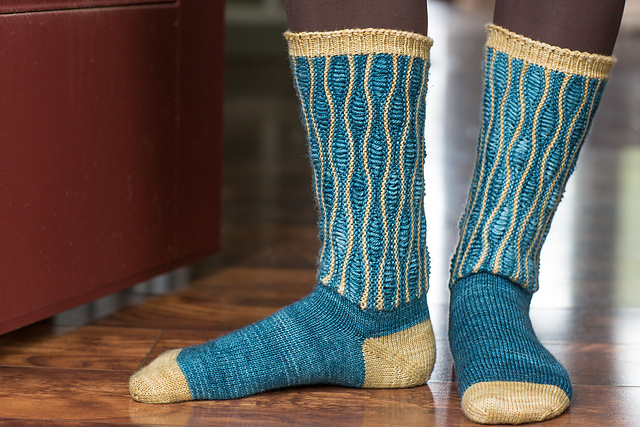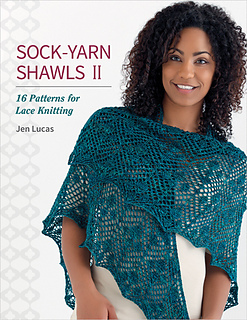Welcome to Tinking Turtle’s week of 5: 5 Interviews, 5 Patterns, 5 Designers, a 5 day extravaganza to celebrate the newest issue of Sockupied: Spring 2015. This issue is very special: it’s the first issue that new Sockupied Editor Amy Palmer curated from start to finish. It also marks Interweave’s Sockupied being released in a new format – an easy to download PDF that’s viewable on a variety of devices!
 |
| © Sockupied/Harper Point |
Today’s interview is brought to you by my own pattern, Karner Butterfly, and Anzula’s beautiful Squishy. Instead of interviewing myself, I thought it’d be more interesting to talk to Amy Palmer, and boy are you in for a treat! Amy Palmer is the lovely editor of Knitscene and Sockupied. When she’s not thinking about knitting, she enjoys learning the violin and reading comics. I love how Amy gives us a glimpse into what happens behind the scenes at Interweave!
This is the first issue of Sockupied you curated start to finish! Tell me a little about why you picked these five designs for this issue. What were the considerations you take into account when creating a collection of socks?
 Amy:I wish I could say there was some magic formula to choosing sock patterns for this issue, but mostly it was “ooh that’s pretty!”
Amy:I wish I could say there was some magic formula to choosing sock patterns for this issue, but mostly it was “ooh that’s pretty!”
I reached out to Rachel Coopey and asked her to be the featured designer, then let her run with her design—she showed me some sketches of her Laith Socks but Rachel’s such a great designer of fun-to-knit socks I never felt the need to peek over her shoulder, so to speak.
One of the things I’d loved about previous issues of Sockupied was the One Sock Two Ways pattern, and Mone Dräger’s submission for Chains Socks was absolutely perfect for that feature.
Kate Atherley’s Washington State Knee Socks grew out of a batch of ideas she’d sent me for Knitscene, I think. The accompanying article was something I knew I wanted to read—I love the look of knee socks but, as a lady with substantial calves myself, I’ve always been a little leery of putting in the time and effort to customize them.
I thought the Karner Butterfly socks you’d submitted were a really cool take on knitting a cuff, though I then had a lot of trouble figuring out if they fell into the “top down” category or if they just needed their own identifier!
Finally I loved M K Nance’s swirling ribbing on her Mill Ends Socks. Now that I think about it there’s a bit of swirling in that pattern, Chains, and Laith. I like swirls, I guess!
Inheriting this project from Anne [Merrow] meant I had some guidelines to help me, which was really helpful. I didn’t have specific themes for the patterns themselves, but I tried to tie everything together with yarn color and photography—the blues and greens of the yarns felt really cohesive, and shooting everything in one location in a lifestyle-photography way really appealed to me, coming from Knitscene where I try to photograph the stories very thematically. But I knew I needed a mix of toe up and top down socks. Sockupied is aimed at experienced sock knitters AND a digital product, so I knew that I could include projects that seemed more challenging to my Knitscene-trained eye without worrying about difficulty level or page space.
How do you make decisions as far as yarns or colors? How much do you take into account designer’s vision vs. wanting the collection to work together?
Amy: Generally I have a working palette, but since the samples are also returned to designers and I want them to enjoy them, I do try to work with designers on color. If I pitch a color and a designer just isn’t feeling it, there’s always some other color that fits into my palette that we can agree on!
All the designers were working on our socks during the Summer of 2014, and sent them to you shortly after, where you saw them for the first time. What happens after you get the designs?
Amy: In a typical magazine production schedule, projects and patterns go to tech editing within a few weeks after the samples arriving in the office. For Sockupied, I needed to get things photographed sooner rather than later due to Knitscene schedule conflicts. The socks for both Spring and Fall were photographed in early September, then the Spring socks were sent to tech editing.
This photo shoot was a fun experience—we shot both issues in one day. The morning/Spring shoot was done at the house of our managing editor, Allison, and she’s also our model (along with her incredibly photogenic golden retriever, Henry). Then we moved locations for the Fall shoot and I’m not telling you anything more about that because it’s a secret. 😉
Did you run into any problems or challenges when you were working on this issue of Sockupied? What did you, or your team, do to overcome it or problem solve it?
Amy: Because I was new to the Sockupied process and not familiar with the schedule, I accidentally backed myself (and by association, my designers—sorry!) into a bit of a corner with getting samples made.
I can’t stress enough how appreciative I am that everyone involved, especially with this Spring issue, was understanding and able to work with me and I promise I don’t usually cut things quite so short! Because our graphic designer for Sockupied is also the graphic designer for Interweave Crochet and Knitscene, we ran into a bit of a crunch as she was working to get Interweave Crochet Spring 2015 out the door, but we’ve kind of become pros at turning files around quickly.
What are 3-5 things you are loving lately?
Amy: I’ve become incredibly enamored with embroidery of late—my mom had given me a bunch of her old embroidery samplers and I’ve been working on one of them, which has led me down a dangerous rabbit hole where things like cross-stitch patterns from Satsuma Street make me really excited (I blame Allyson Dykhuizen for that link). I’m also trying to work on the ones I have so I haven’t purchased any patterns yet.
It’s no secret that I’m a bit of a nerd, so I’ve been working on my embroidery and knitting projects while re-watching Star Trek: The Next Generation. (Thanks Netflix!) I’m loving this because it reminds me of when I was a little girl—this was the first show I remember watching with my dad and it was our “thing” for a while. Plus it’s great crafting entertainment!
And this may seem like a cop-out but I’m really really excited about Knitscene Summer. We have some incredible projects in this issue and the photography was just so fun and fresh I can’t
wait to share it with everyone. This issue also marks my debut as a garment designer so that makes me kind of nervous in an excited kind of way. So I guess I should get back to work on that, huh?
 |
| © Sockupied/Harper Point |
Today’s interview is sponsored by Karner Butterfly, my own socks! Karner Butterfly was inspired by the small blue butterflies native to my hometown, in an area called the Pine Bush. The Karner Butterflies are more commonly known as Karner Blue – the butterfly being a bright blue with small gold spots. The butterfly’s habitat depends on the growth of the plant blue lupine, and as such, is endangered.
The blue and gold of the butterfly a almost perfectly captured by Anzula’s Squishy in Teal and Maple. Many thanks to Anzula for providing yarn support! Anzula also provided one of the prizes in the giveaway: a skein of Squishy!
To enter the contest, use the Rafflecopter widget below! You can enter the contest multiple times by doing different things – so have fun with it. We will have three winners to the drawing, be sure to scroll through and see all the great prizes!




























